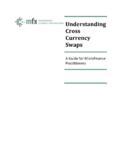Transcription of Understanding FX Forwards - MicroRate
1 Understanding FX Forwards A Guide for Microfinance Practitioners 2 Forwards Use: Forward exchange contracts are used by market participants to lock in an exchange rate on a specific date. An Outright Forward is a binding obligation for a physical exchange of funds at a future date at an agreed on rate. There is no payment upfront. Non-Deliverable Forwards (NDF) are similar but allow hedging of currencies where government regulations restrict foreign access to local currency or the parties want to compensate for risk without a physical exchange of funds. NDFs settle against a fixing rate at maturity, with the net amount in USD, or another fully convertible currency , either paid or received.
2 Since each forward contract carries a specific delivery or fixing date, Forwards are more suited to hedging the foreign exchange risk on a bullet principal repayment as opposed to a stream of interest and principal payments. The latter is more often covered with a cross currency swap. In practice, however, Forwards are sometimes favored as a more affordable, albeit less effective, hedging mechanism than swaps when used to hedge the foreign exchange risk of the principal of a loan, while leaving interest payments uncovered. Structure: An outright forward locks in an exchange rate or the forward rate for an exchange of specified funds at a future value (delivery) date. Outright Forward Contract In an NDF a principal amount, forward exchange rate, fixing date and forward date, are all agreed on the trade date and form the basis for the net settlement that is made at maturity in a fully convertible currency .
3 At maturity of the NDF, in order to calculate the net settlement, the forward exchange rate agreed at execution is set against the prevailing market 'spot exchange rate' on the fixing date which is two days before the value (delivery) date of the NDF. The reference for the spot exchange rate the fixing basis varies from currency to currency and can be the Reuters or Bloomberg pages. Non-Deliverable Forward Contract 3 On the fixing date, the difference between the forward rate and the prevailing spot rate are subtracted resulting in the net amount which has to be paid by one party to the other as settlement of the NDF on the value (delivery) date. Pricing: The "forward rate" or the price of an outright forward contract is based on the spot rate at the time the deal is booked, with an adjustment for "forward points" which represents the interest rate differential between the two currencies concerned.
4 Using the example of the Dollar and the Ethiopian Birr with a spot exchange rate of USD-ETB= and one-year interest rates of and respectively for the and Ethiopia, we can calculate the one year forward rate as follows: Forward Rate: (Multiplying Spot Rate with the Interest Rate Differential): The forward points reflect interest rate differentials between two currencies. They can be positive or negative depending on which currency has the lower or higher interest rate. In effect, the higher yielding currency will be discounted going forward and vice versa. In an NDF, the forward rate used follows the same methodology as the outright forward, but the actual funds exchanged on the value date at maturity will depend on the prevailing spot exchange rate.
5 If the prevailing spot rate is worse than the forward rate, the NDF is an asset and the holder of the NDF will be receiving funds from the counterparty as settlement. The opposite holds true if the NDF contract is a liability because prevailing spot rates are better that the original forward rate agreed at inception. 4 In the two cases above, the USD difference represents the gain or liability on the transaction. The receipt or payment in USD via the NDF is offset by the loss or gain in USD-ETB move. Constraints: If the underlying reason for wishing to set the exchange rate for a future delivery date no longer exists, the forward exchange contract may need to be cancelled at prevailing market rates. The unwinding of the position may incur a profit or a loss.
6 ( the 'mark to market' value of the contract). currency markets are highly volatile and the prices of the underlying currencies can fluctuate rapidly and over wide ranges and may reflect unforeseen events or changes in conditions 5 Forward Contract Pros Forward Contract Cons No upfront cost Counterparty risk failure to deliver funds at the delivery date Entering into a forward exchange contract fixes the exchange rate for a future delivery date Opportunity cost precludes any future benefit or cost from subsequent exchange rate movements.


